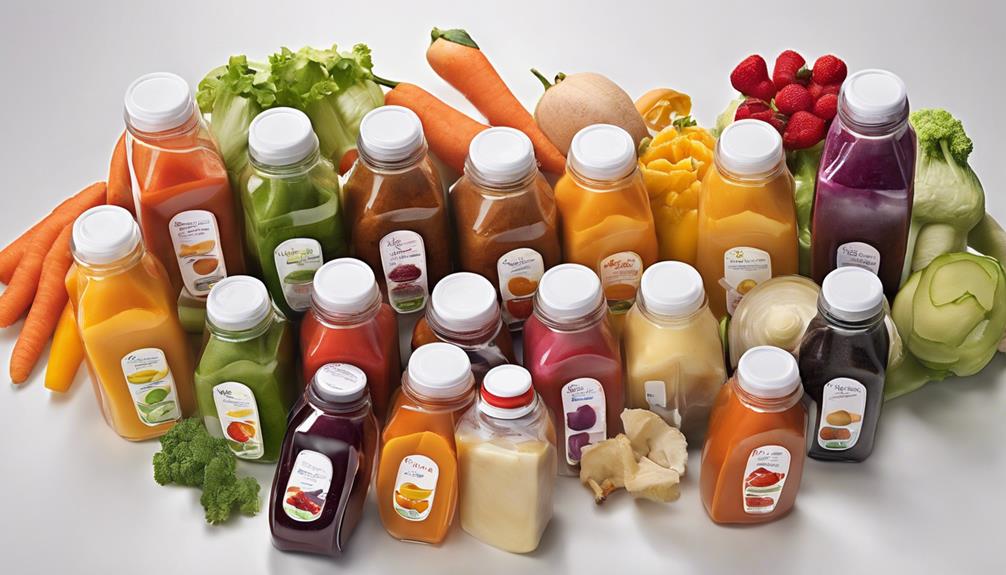Imagine a situation in which a new parent, Sarah, is having a difficult time figuring out a feeding schedule that suits both her and her baby. With doubts about whether to exclusively pump or introduce formula, she is looking for advice on how to start this feeding journey.
She discovers the intricate balance between milk production, equipment essentials, and self-care practices. Understanding the challenges and benefits of both exclusive pumping and formula feeding is important for her baby's well-being.
Curious to explore how Sarah tackles these challenges and finds a path that suits her best?
Key Takeaways
- Precise control over feeding schedules and milk intake monitoring.
- Support for mothers facing latch issues and involving partners in feeding routine.
- Manage milk supply by pumping 8-12 times daily initially.
- Combine formula feeding gradually while continuing to pump for a balanced approach.
Exclusively Pumping: Benefits and Considerations
Exclusively pumping offers mothers the advantage of having precise control over feeding schedules and the ability to accurately monitor their baby's milk intake. This method can be particularly beneficial for mothers facing latch issues during breastfeeding or those who prefer the flexibility that exclusive pumping provides.
While establishing and maintaining milk supply through exclusive pumping may initially require pumping 8-12 times a day, the personalized support from a lactation consultant can make this process smoother and more manageable. One key benefit of exclusively pumping is the ability to involve partners or caregivers in the feeding routine, allowing for shared responsibilities and bonding opportunities.
Establishing a Formula Feeding Routine

When establishing a formula feeding routine, consulting a pediatrician for guidance on selecting the most suitable formula based on the baby's specific needs and age is essential. Following feeding guidelines is vital for healthy growth. It's important to monitor weight gain and pay attention to feeding cues to make certain the baby is getting enough nutrition.
Creating a feeding schedule that includes formula feeds alongside other feeding methods can help in establishing a balanced routine. Consistency in feeding routines plays a significant role in a baby's development. By working closely with your pediatrician, you can tailor the feeding plan to meet your baby's individual requirements, promoting their overall well-being.
Exclusive Pumping Equipment Essentials
To optimize the efficiency and effectiveness of exclusive pumping, investing in high-quality equipment is essential for maintaining a successful pumping routine. Hospital-grade breast pumps are recommended for efficient milk extraction and establishing a strong milk supply. Hands-free pumping bras enhance convenience by allowing multitasking during pumping sessions. Properly fitting breast shields ensure comfort and maximize pumping efficiency. Safe storage containers and labeling practices are essential for maintaining the quality and freshness of pumped breast milk. Regular maintenance and replacement of pump parts are crucial for optimal performance and hygiene.
| Equipment | Description | Importance |
|---|---|---|
| Breast Pump | Hospital-grade pumps are recommended for efficient milk extraction. | Essential for milk supply |
| Hands-Free Bra | Enhances convenience by allowing multitasking during pumping sessions. | Improved efficiency |
| Breast Shields | Proper fit ensures comfort and maximizes pumping efficiency. | Comfort and efficiency |
| Milk Storage | Safe containers and labeling practices maintain quality and freshness of milk. | Preserving milk quality |
| Pump Parts | Regular maintenance and replacement are crucial for optimal performance and hygiene. | Performance and hygiene |
Managing Milk Supply and Demand

Managing milk supply and demand requires a strategic approach that involves understanding the frequency and volume of milk production needed to meet the baby's nutritional requirements.
To maintain a healthy milk supply while exclusively pumping, aiming for a pumping frequency of 8-12 times per day initially is vital. It's recommended to produce 2-3 ounces of milk every 2-3 hours to adequately meet the baby's needs.
As the baby grows, targeting a daily milk output of 24 ounces by 6 months and gradually reducing to 16 ounces daily by 1 year helps in balancing milk production. Adjusting pumping duration and frequency according to the baby's demand is key in managing milk supply effectively.
Consistency in your pumping schedule and ensuring proper hydration are essential factors for maintaining a steady milk supply. By staying attentive to these aspects, you can better meet your baby's feeding requirements while exclusively pumping.
Combining Exclusively Pumping With Formula Feeding
Moving from focusing solely on managing milk supply and demand, we now explore how to effectively combine exclusively pumping with formula feeding for a balanced approach to infant nutrition.
When shifting between breast milk and formula, it's crucial to maintain your milk supply by gradually introducing formula feeding while continuing to pump. Seek guidance from healthcare providers on the best way to combine pumping with formula feeding to make sure your baby receives adequate nutrition.
Monitor your baby's reaction to formula and adjust the feeding routine accordingly to meet their needs. Utilizing a paced bottle feeding method can help ease the change and prevent feeding issues. Keep track of the amount of formula consumed to maintain a balanced feeding schedule that suits your baby's requirements.
Frequently Asked Questions
How Do You Combo Feed Pumping and Formula?
When combo feeding with pumping and formula, we gradually introduce formula feeds alongside pumping sessions to establish a balanced routine. We monitor baby's response and adjust quantities based on cues and milk supply.
Seeking guidance from healthcare providers guarantees the best nutrition. Consistency in the pumping schedule is essential while incorporating formula feeds.
Using paced bottle feeding techniques helps promote healthy habits during combo feeding for our little one's well-being.
Is It Okay to Exclusively Pump and Bottle Feed?
Definitely! We're here for you. Exclusively pumping and bottle feeding can be a fantastic choice for many moms. It offers flexibility, control, and can be necessary in various situations.
With dedication and proper milk management, many moms successfully provide breast milk exclusively through pumping and bottle feeding.
It's a valid and empowering option that can work wonders for both mom and baby. So, go ahead and give it a try!
Why Is Mixed Feeding Not Recommended?
Mixed feeding isn't recommended due to potential issues like nipple confusion, reduced milk supply, and disrupted feeding routines. Introducing formula early may hinder effective latching and impact the baby's gut microbiome.
Experts advise against mixed feeding to guarantee successful breastfeeding success and milk supply regulation. It's vital to establish a consistent feeding pattern for the baby's well-being and to support successful breastfeeding.
How Often Should I Feed My Baby When Exclusively Pumping?
When exclusively pumping, we need to feed our baby every 2-3 hours, aiming for 8-12 times a day. It's vital to pump for 15 minutes per breast or 20-25 minutes when double pumping.
Can Organic Tube Feeding Formulas Be Used for Exclusively Pumping and Formula Feeding?
Organic tube feeding formulas complete are specially designed for individuals who are unable to consume food orally. Using them for exclusively pumping and formula feeding can provide a source of balanced nutrition. However, it is crucial to consult a healthcare professional before using these formulas in non-traditional ways.
Conclusion
As we navigate the intricate dance of exclusive pumping and formula feeding, we become like the symphony conductor, orchestrating the perfect blend of milk supply and formula to create a harmonious feeding routine.
Just as each note contributes to the melody, every pump session and bottle feed plays a vital role in nourishing our little ones.
With dedication, support, and the right tools at hand, we can confidently lead this feeding journey with grace and confidence.










